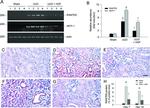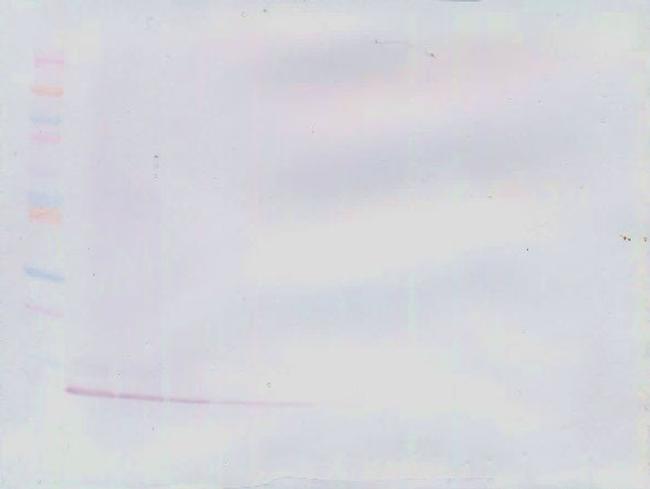RANTES, Anti-Murine
Cat# NB-50-0667-100
Size : 100µg
Brand : Neo Biotech

Product Image Gallery

Western Blot: To detect Murine RANTES (CCL5) by Western Blot analysis CCL5 (RANTES) Polyclonal Antibody (Product # 500-P118-1MG) can be used at a concentration of 0.1-0.2 µg/mL. Used in conjunction with compatible secondary reagents the detection limit for Recombinant Murine RANTES (CCL5) is 1.5-3.0 ng/lane, under either reducing or non-reducing conditions.

Western Blot: To detect Murine RANTES (CCL5) by Western Blot analysis CCL5 (RANTES) Polyclonal Antibody (Product # 500-P118-1MG) can be used at a concentration of 0.1-0.2 µg/mL. Used in conjunction with compatible secondary reagents the detection limit for Recombinant Murine RANTES (CCL5) is 1.5-3.0 ng/lane, under either reducing or non-reducing conditions.

Sandwich ELISA: To detect Murine RANTES (CCL5) by sandwich ELISA (using 100 µL/well antibody solution) a concentration of 0.5-2.0 µg/mL of CCL5 (RANTES) Polyclonal Antibody (Product # 500-P118-1MG) is required. This antigen affinity purified antibody, in conjunction with PeproTech CCL5 (RANTES) Polyclonal Antibody, Biotin (Product # 500-P118BT-1MG) as a detection antibody, allows the detection of at least 0.2-0.4 ng/well of Recombinant Murine RANTES (CCL5).

Ectopic expression of Id1 potentiates RANTES induction in tubular epithelial cells and promotes monocyte chemotaxis ( a , b ) Id1 potentiates RANTES expression in response to TNF-alpha stimulation. HKC-8 cells transfected with either Id1 expression vector or pcDNA3 empty plasmid were treated with different doses of TNF-alpha for 24 h as indicated. Cell lysates were immunoblotted with antibodies against RANTES or alpha-tubulin, respectively. Representative Western blot ( a ) and quantitative data of RANTES expression in various groups ( b ) are presented. * P < 0.05 versus pcDNA3 control (n = 3). ( c ) Id1 promotes the chemoattraction of tubular epithelial HKC-8 cells to THP-1 monocytes in vitro. Id1-overexpressing HKC-8 cells and controls cells were treated with TNF-alpha for 24 h. Conditioned media were collected for chemotaxis assay to assess their ability to attract THP-1 cells to migrate across the filter of Transwell chambers. Data are expressed as the percentage of migrated cells in total cells added. * P < 0.05 versus pcDNA3 control (n = 3). ( d ) Immunohistochemical staining shows an induction of RANTES protein in the degenerated tubules (*) in the obstructed kidneys at 7 days after UUO. Scale bar, 50 mum.
Product Details
500-P118-100UG
Species Reactivity
Published species
Host/Isotype
Class
Type
Immunogen
Conjugate
Form
Concentration
Purification
Storage buffer
Contains
Storage conditions
Shipping conditions
RRID
Product Specific Information
AA Sequence of recombinant protein: SPYGSDTTPC CFAYLSLALP RAHVKEYFYT SSKCSNLAVV FVTRRNRQVC ANPEKKWVQE YINYLEMS.
Preparation: Produced from sera of rabbits immunized with highly pure Recombinant Murine RANTES (CCL5). Anti-Murine RANTES (CCL5)-specific antibody was purified by affinity chromatography employing an immobilized Murine RANTES (CCL5) matrix.
Sandwich ELISA: To detect Murine RANTES (CCL5) by sandwich ELISA (using 100 µL/well antibody solution) a concentration of 0.5-2.0 µg/mL of this antibody is required. This antigen affinity purified antibody, in conjunction with PeproTech Biotinylated Anti-Murine RANTES (CCL5) (500-P118Bt) as a detection antibody, allows the detection of at least 0.2-0.4 ng/well of Recombinant Murine RANTES (CCL5).
Western Blot: To detect Murine RANTES (CCL5) by Western Blot analysis this antibody can be used at a concentration of 0.1-0.2 µg/mL. Used in conjunction with compatible secondary reagents the detection limit for Recombinant Murine RANTES (CCL5) is 1.5-3.0 ng/lane, under either reducing or non-reducing conditions.
Target Information
CCL5 (RANTES) is a chemokine gene located on the q-arm of chromosome 17. Chemokines are a superfamily of secreted proteins involved in immunoregulatory and inflammatory processes. The superfamily is divided into four subfamilies based on the arrangement of the N-terminal cysteine residues of the mature peptide. CCL5, a member of the CC subfamily, functions as a chemoattractant for blood monocytes, memory T helper cells, and eosinophils. It causes the release of histamine from basophils and activates eosinophils. This cytokine is one of the major HIV-suppressive factors produced by CD8+ cells. It functions as one of the natural ligands for the chemokine receptor chemokine (C-C motif) receptor 5 (CCR5), and it suppresses in vitro replication of the R5 strains of HIV-1, which use CCR5 as a coreceptor. Alternative splicing results in multiple transcript variants that encode different isoforms. Diseases associated with CCL5 include Human Immunodeficiency Virus Type 1 and Periapical Granuloma.
For Research Use Only. Not for use in diagnostic procedures. Not for resale without express authorization.





